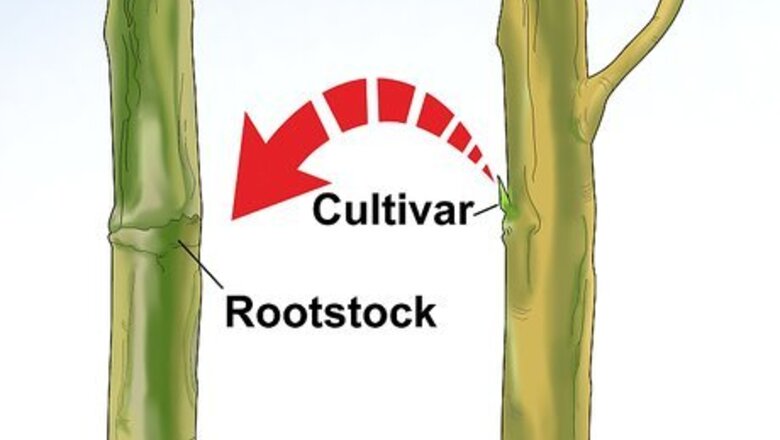
views
Using T-Budding
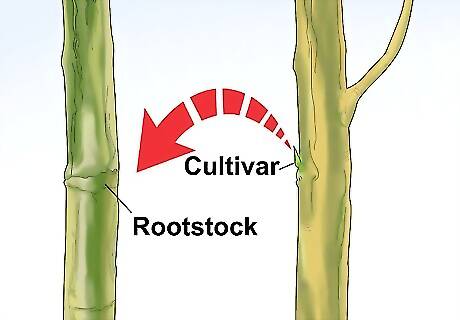
Choose your cultivar and your rootstock. In order for your budding to be successful, you must cut a scion (small piece for grafting) from a healthy, disease-free cultivar (origin tree) as well as a suitable growing tree (rootstock). The rootstock in this case is an established tree that the scion can be spliced into. For T-budding, the bark of both trees must be "slipping." This means the bark is easily peeled off and the green layer underneath is moist, which usually occurs in the spring. Try irrigating them well to help them along. T-Budding is typically used for fruit tree propagation.
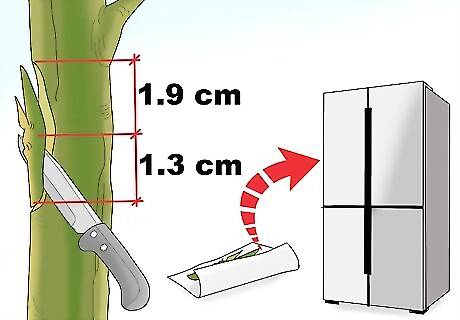
Cut a scion. For T-budding, you must cut into the branch ⁄2 inch (1.3 cm) below the bud to ⁄4 inch (1.9 cm) beyond the bud. Make the cut as deep as needed to include the soft, green layer beneath the bark but not any deeper. This green material must be exposed on your scion for a successful graft. If you must store your scion bud, wrap it in a damp paper towel, place it in a polyethylene bag, and store it in a refrigerator.

Make a T-cut on your rootstock. Choose a space on a branch or sapling that is ⁄4 inch (0.6 cm) to 1 inch (2.5 cm) in diameter. The space must be free of any buds, ideally far from any buds. Make a vertical slice in the bark about 1 inch (2.5 cm) long and deep enough to expose that green layer. Make a horizontal slice of the same depth that is about one third the distance around the rootstock. Twist the knife in the juncture of the slices to create flaps of the bark, making the green layer visible.
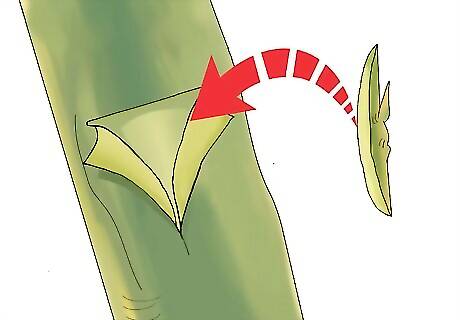
Introduce the scion. Slip the scion containing the bud under the flaps you've just created on the rootstock, taking care not to introduce any dirt or germs. If part of the scion's bark sticks out above the T-cut, slice it off so that everything fits together snugly.

Tie the scion to the rootstock. Wrap a stretchy rubber material such as grafting rubber around the rootstock to hold the scion in place. Be careful not to jostle or cover the bud.
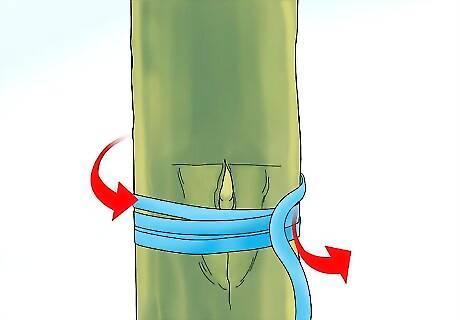
Remove the tie. In about a month, the rubber you wrapped around the rootstock may loosen and fall off. If it doesn't, gently remove it yourself so that the area will not be constricted.
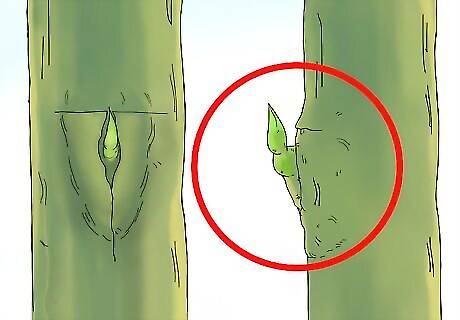
Follow up on your bud. If the bud looks plump and healthy, it is probably alive. If it looks shriveled, then it has died and you'll have to start again.
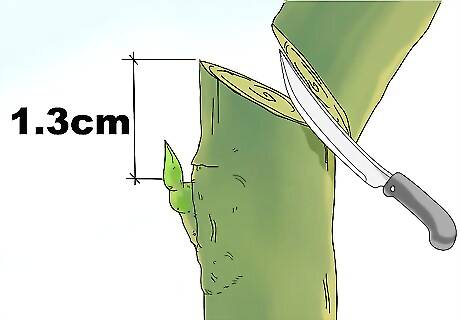
Remove other material. The next spring, once the bud has begun to sprout leaves, make a sloped cut ⁄2 inch (1.3 cm) above the successful bud. Remove all other side shoots below the bud. This will promote growth of the grafted bud since it will be the only thing being nourished by the rootstock.
Trying Chip Budding

Choose your cultivar and your rootstock. In chip budding, the diameters of the scion and the rootstock should be the same diameter. If they're not, you'll have to cut them differently so that the green layers match up when combined. Chip Budding is one of the easiest ways to graft, and is particularly good for fruit trees.
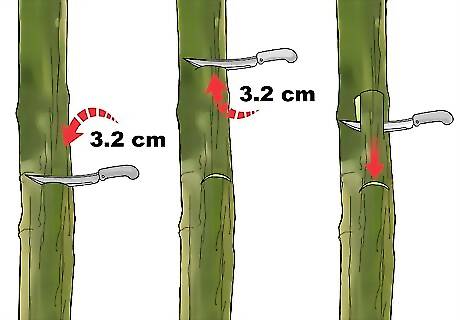
Cut a slice from your rootstock. Make a small angled cut about 1/5 to 1/4 the rootstock's diameter into the rootstock. Slice your knife downward at this depth for 1 ⁄4 to 1 ⁄2 inches (3.2 to 3.8 cm). Remove your knife without severing the bark. Move the knife upward a small amount and then cut back in and downward to meet the end of the initial slice to create a small notch. Remove the chunk of bark from the rootstock.
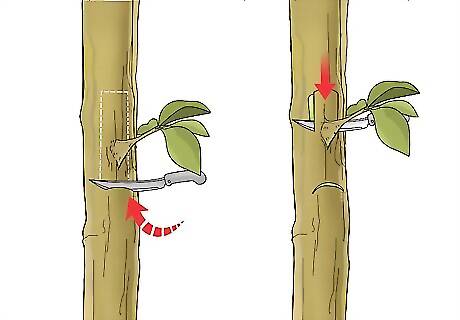
Cut a scion from your cultivar. Use the chunk cut from your rootstock as the model for your scion, using the scion bud as the center point of the new cutting. You want the scion to fit into the space made in the rootstock as neatly as possible.
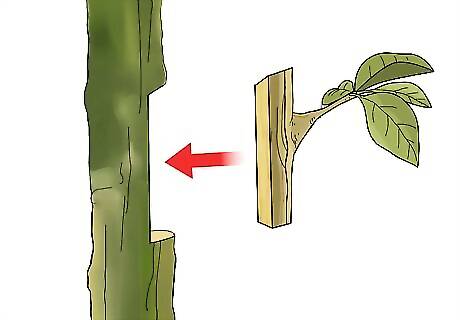
Introduce the scion to the rootstock. Slip the scion down into the notch at the bottom of the rootstock cut. Make sure that the green layers of the scion and rootstock are touching all the way around the edges. If they are not, the graft will fail.
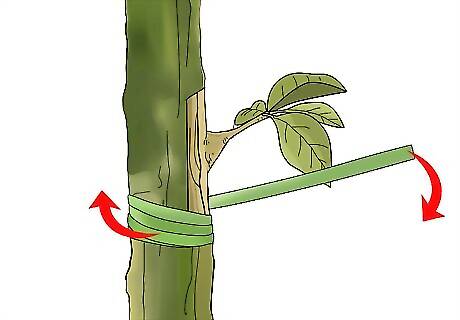
Secure the scion. Wrap a stretchy rubber material around the rootstock to hold the scion in place. Polyethylene tape is preferable. Be careful not to jostle or cover the bud. Some of the specifics of this process will depend on what kind of tree you are growing and what kind of material you're using. For example, if you use grafting tape and grafting an apple tree, you had better cover the whole thing with the tape, as the tape will protect the bud from drying, and it will be torn by the bud as it grows. But other materials may not give the same protection, and may be more difficult to tear. Large buds are difficult to fully cover, and can be exposed to air. It depends on the fruit.
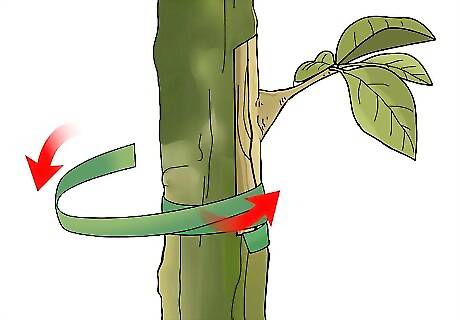
Remove the tie. In about a month, the rubber you wrapped around the rootstock may loosen and fall off. If it doesn't, gently remove it yourself so that the area will not be constricted.
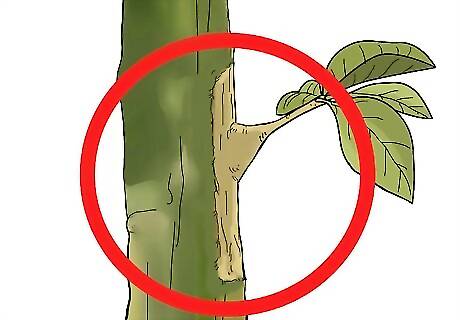
Follow up on your bud. If the bud looks plump and healthy, it is probably alive. If it looks shriveled, then it has died and you'll have to start again.
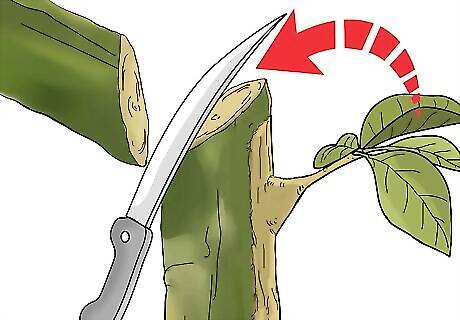
Remove other material. The next spring, once the bud has begun to sprout leaves, make a sloped cut ⁄2 inch (1.3 cm) above the successful bud. Remove all other growth below the bud to promote growth through the grafted bud.
Using Whip Grafting

Choose your cultivar and your rootstock. Whip grafting can only be used to join rootstock and scions that are the same diameter, ideally between 1/4 and 1/2 inch in diameter. The graft must be made after the threat of cold but before the bark of the stock begins slipping (peels off easily). The scion must be dormant (not sprouting) at this time, and should be a twig about a foot long containing three to five buds.

Prepare the scion. Remove the terminal end of the scion. At the base of the scion, make a sloping cut to remove that end.
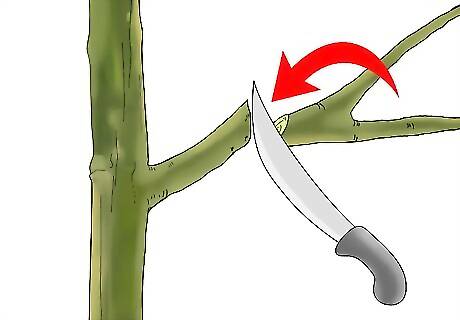
Prepare the rootstock. Make a sloping cut across the chosen branch that mirrors the one you made on the scion. They should fit together precisely.

Cut tongues. Make matching slices down into both the rootstock and the scion in such a way that they can hook into each other.
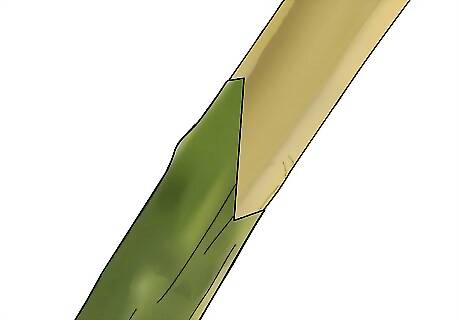
Introduce the scion. Place the scion slightly offset from the rootstock and slide it down so that the tongues overlap. Make sure that the layer of green wood beneath the bark of both parties aligns or the graft will not take.

Secure the scion. Wrap a stretchy rubber material around the graft site to hold the scion in place. Grafting tape works well. If using a different material, be sure to remove it in about a month.
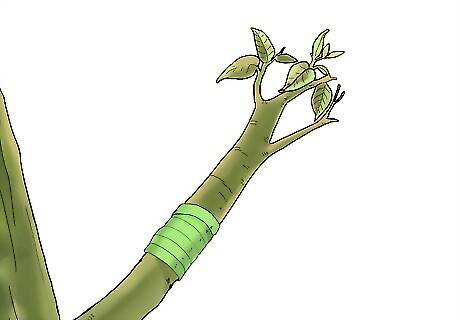
Look after the graft. Once the graft is planted, keep an eye out for new growth below the graft, as you may need to remove it. At first, you can leave some leaves on the rootstock so that nutrients keep flowing up the tree until the graft is successful. However, if you see an actual young branch/shoot forming on the trunk of the rootstock, remove it; this will help encourage the scion to grow. Once the scion really starts to grow and a few new leaves appear above the graft (5 or so healthy leaves), remove any further growths from the rootstock, below the graft. This removal will help the plant thrive with growth on the scion, rather than the rootstock, and has to be done as long as the tree is alive. Otherwise, the rootstock will try to make its own branches; you'll need to remove them whenever they grow.
Trying Bark Grafting
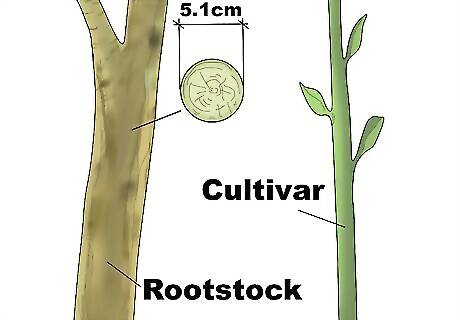
Choose your cultivar and your rootstock. Scions should be up to three dormant, or not currently sprouting, twigs of about a foot long containing three to five buds. Don't cut scion and rootstock at the same time. Rootstock should be straight, smooth, vertical branches 1–2 inches (2.5–5.1 cm) in diameter. Bark grafts should be performed once the rootstock bark has begun slipping (when the bark is easily peeled off in spring). This graft is usually used for instances in which the rootstock is too big for whip grafting.

Amputate the rootstock. Above a crotch out of which several branches grow, cut straight across one branch with a very sharp saw so as not to crack or rip the bark or wood of the branch. Make sure you leave a branch nearby to keep nutrients moving up the tree.
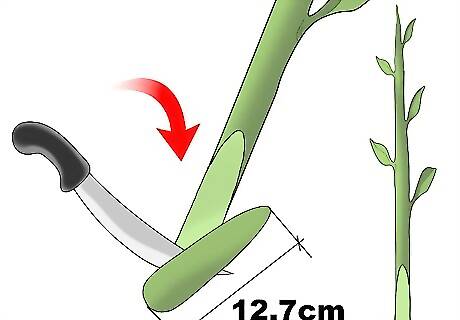
Prepare the scions. Cut the scions down to around 5 inches (12.7 cm) in length while still retaining about 5 buds per scion. Around three inches from the base of the scion, make a sloping cut inward until you reach the base.
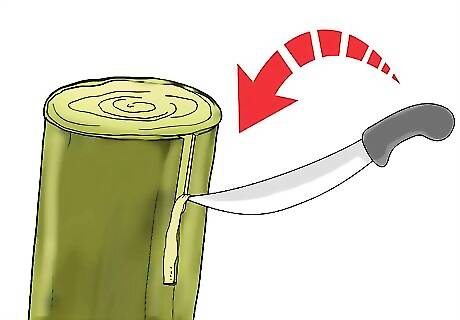
Prepare the rootstock. Hold each scion up against the rootstock so that about ⁄8 inch (0.3 cm) of the cut surface of the scion shows above the rootstock. With a sharp knife, outline each scion on the rootstock. Remove the scions and finish cutting away this bark so that each will fit snugly into its space.
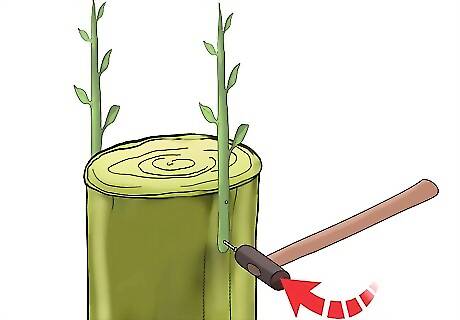
Introduce the scions. Place each scion in its space on the rootstock, taking special care to ensure the green wood of both parties aligns exactly. Once in place, hammer two wire nails into each scion to hold them into the tree.
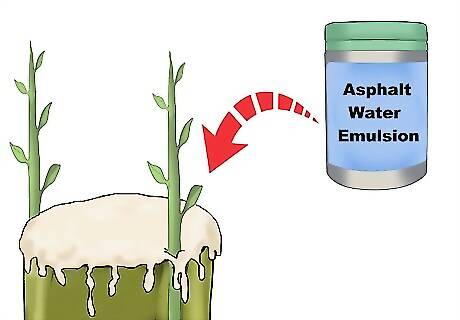
Seal the graft. Pour grafting wax or asphalt water emulsion over the area to seal all cut surfaces from drying and bacteria. Check the seal again the next day to make sure no holes have formed.
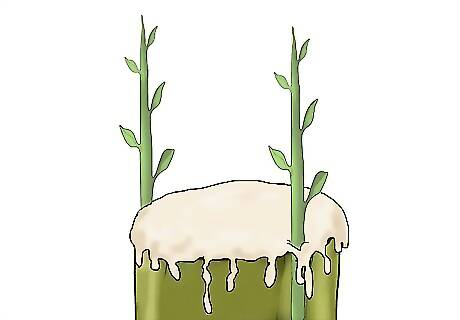
Look after the graft. Keep removing all growth below the graft. Once one scion shows more promise than the other(s), leave that one as is while pruning the less successful graft(s). Two summers after grafting, remove all but the strongest scion.
Using Cleft Grafting

Choose your cultivar and your rootstock. Scions should be two dormant, or not currently sprouting, twig of about a foot long containing three to five buds. Rootstock should be straight, smooth, vertical branches 1–2 inches (2.5–5.1 cm) in diameter. Cleft grafts should be performed right before the bark of the rootstock starts slipping (being easily peeled off) in spring. This graft is usually used for top working (changing the type of fruit) of a mature tree by being performed on a number of branches.
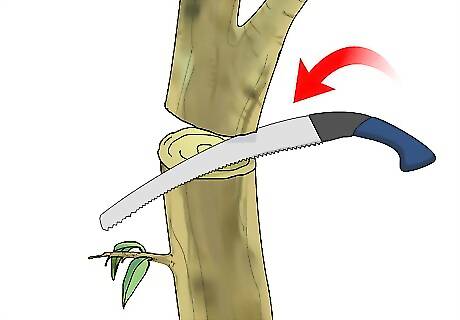
Amputate your rootstock. Choose a point below which the branch is straight and blemish-free for six inches and then make a clean perpendicular cut, removing the rest of the branch. Be careful not to tear or split the branch or bark. Be sure to leave a branch that has sprouted nearby to keep nutrients moving up the tree.
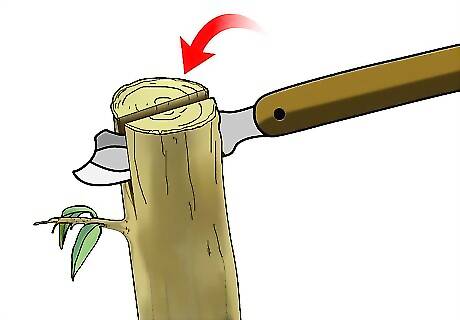
Cleave your rootstock. Use a cleft-graft knife or a hatchet to split the branch straight down the center for about 6 inches (15.2 cm).

Prepare the scions. Remove the tip and the base of the scion. Beginning just below the bottom bud, make a sloping cut on either side of the scion that reaches all the way to the bottom.
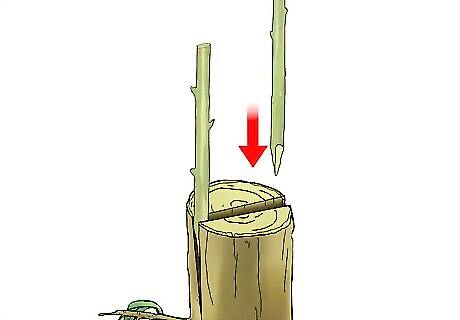
Insert the scions into the rootstock. Using a large screwdriver or small chisel to hold open the cleft in the rootstock, insert a scion into either side of the cleft. Make sure once again that the green layer of the wood, not the bark, is aligned. No cut surface on the scion should be visible above the top of the rootstock.

Seal the graft. Pour grafting wax or asphalt water emulsion over the area to seal all cut surfaces from drying and germs. Check the seal again the next day to make sure no holes have become exposed.
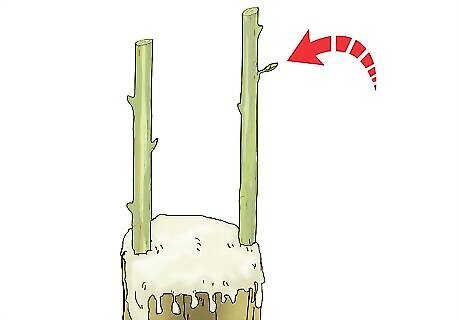
Look after the graft. Keep removing all growth below the graft. Once one scion shows more promise than the other, leave that one as is while pruning the less successful graft. Two summers after grafting, remove all but the strongest scion.


















Comments
0 comment